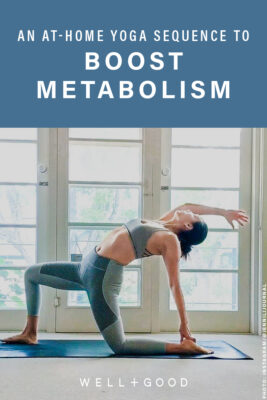Thanks to many aspects of modern life—like chronic stress, environmental toxins, and processed foods that contribute to leaky gut—experts say a surprising number of women are walking around with thyroid issues without realizing it.
And since the thyroid is a gland that regulates metabolism, an underactive one (the most common problem) can lead to downer symptoms like weight gain, fatigue, depression, and low libido. Hardly the stuff of 2017 #goals, right?
Yoga teacher and health coach Fern Olivia experienced many of these before she found out she had Hashimoto's hypothyroidism. After a doctor revealed the treatment was to be on medication indefinitely, she sought out her own holistic path to healing. "Thyroid Yoga is the union of all of these modalities that have helped me," she says, including integrative medicine, Ayurveda, Chinese medicine, Katonah Yoga, Kundalini Yoga, and more.
The practice she created, she says, uses yoga and meditation to revitalize the thyroid, relieve adrenal fatigue, and support the endocrine system, therefore leading to overall hormonal balance and hopefully a humming metabolism. (Though like most holistic practices, there's no scientific evidence for the specific ways these poses benefit the body.) She even created her own line of essential oils, one of which is specifically formulated to support the thyroid and adrenals.
Here, Fern Olivia shares a Thyroid Yoga sequence you can do at home if you've got a hormonal issue of your own—or suspect you might.
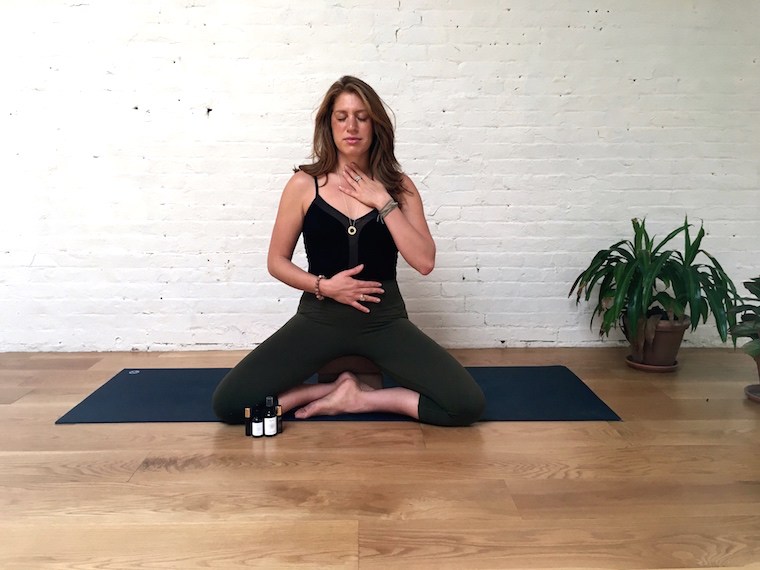
Meditation and intention setting
Sit for a moment in a cross-legged seat with one or two blocks under you to promote length along your spine. Begin each daily practice with a scent (like Radiance Alchemy), affirmation, and breath.

{{post.sponsorText}}
As you sit, reflect on how the practice has ignited your body with radiant health. Notice any shifts you have experienced in your physical and energetic body. Visualize yourself in perfect balance, and repeat this affirmation to yourself as you breathe deeply: “I am grace. Beautiful body, I love you. Beautiful soul, I see you.”
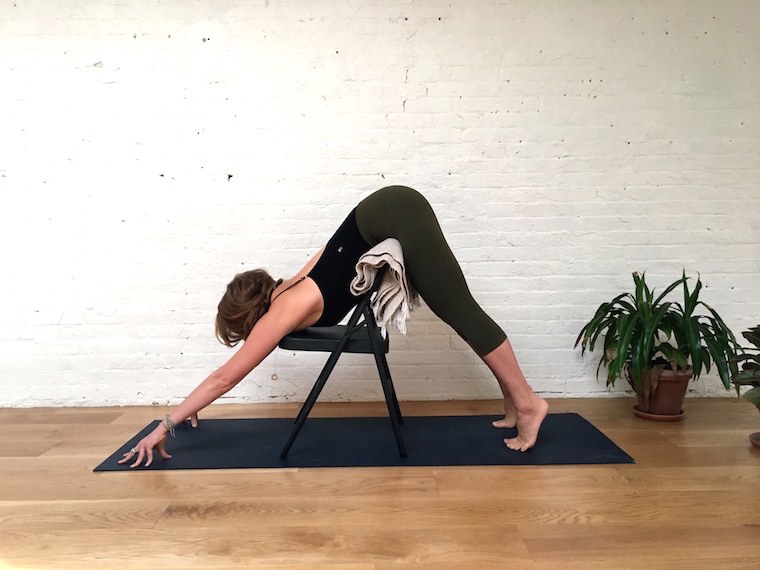
Supported down dog with chair
Place a folded blanket on the back panel of a metal folding chair. Fold your hip crease over the blanket, stretching your legs out behind you and a slight bend in the knees. Arms are extended straight out in front of you on a yoga mat or optionally with hands pressing on blocks for added height. Optionally place blocks under feet as well. Lift and lower heels as you lift your sit bones up, elevating your sacrum and finding elongation in the spine. Gaze out towards your fingertips.
Stay in this pose for at least one minute, inhaling and exhaling deeply. With this pose and all that follow, the pressure on your lower belly may feel uncomfortable at first; blankets can help.
Note: For your safety while practicing this sequence, be sure to place a yoga mat under your folding chair to prevent sliding around. If you're nervous, place pillows around you and remove furniture or other objects nearby. Listen to your body and if something is painful, come out of the pose, reorganize yourself, and only work to where you feel a sensation without pain. I always recommend practicing with a skilled instructor one-on-one, especially if you are new to these poses or are working with an injury or limitation.
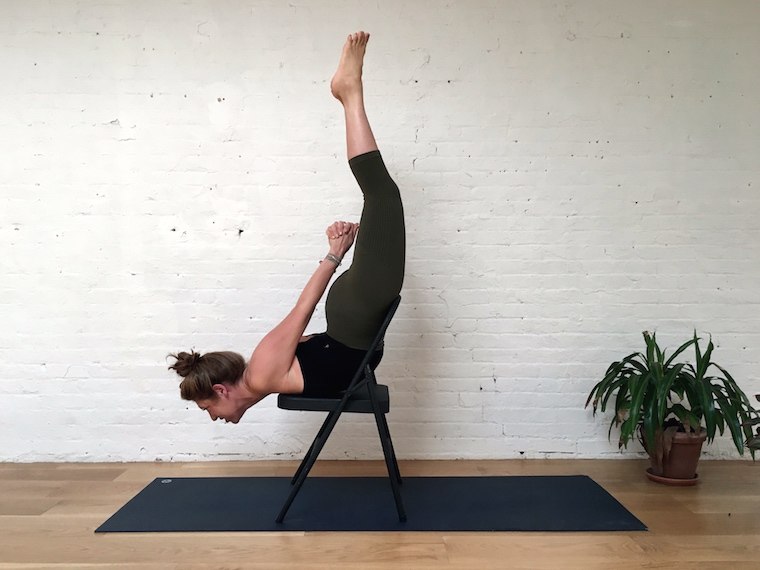
Supported locust pose
From down dog, begin to press your sternum and chest into the chair, gazing forward out ahead of you. Place your palms on the feet of the chair and begin to lift legs up, pressing hips into the chair. Point toes up and squeeze inner thighs together.
If you feel balanced here, reach your arms out to the sides and breathe here, or clasp palms behind your back, pressing your sternum up, clasped palms toward your feet. Stay in this pose for at least five breaths, inhaling and exhaling deeply.
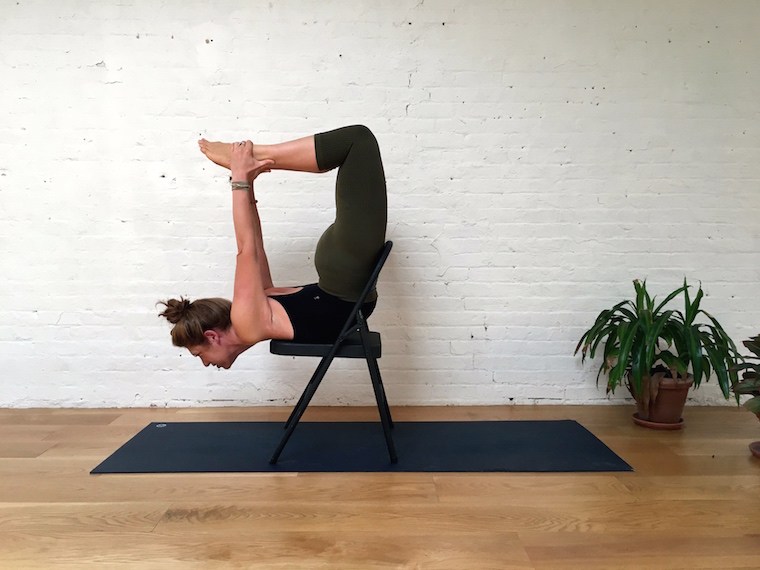
Supported bow pose
From locust pose, reach your palms to clasp your ankles. Equally press your sternum down and up into the chair seat as you lift your knees up and back.
Press hip points and thighs firmly and securely into the back of the chair. Your gaze is out in front of you. Stay in this pose for at least five breaths, inhaling and exhaling deeply.
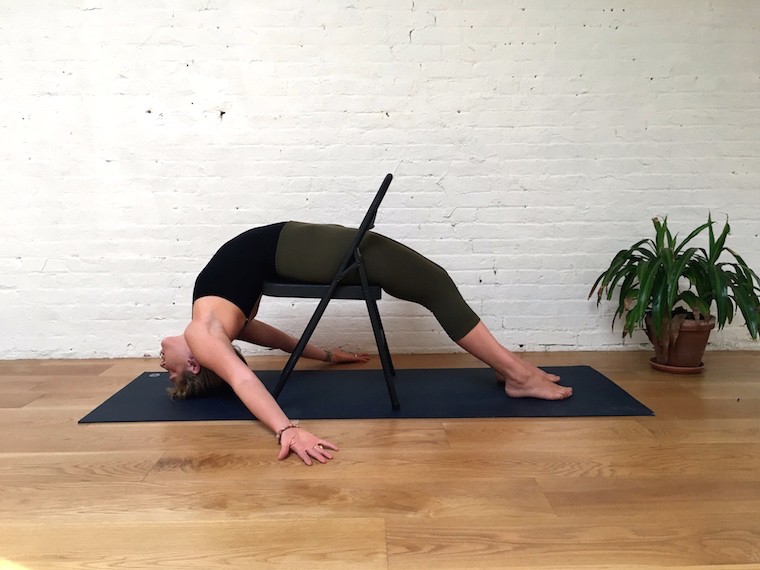
Supported fish pose
From bow pose, slowly lower legs into down dog and take palms to the top of the chair, gently coming up to stand. Re-position yourself on the chair to sit backwards, bringing your feet and legs through the back opening. Keep knees bent with feet on the floor as you begin to lower your torso so your bra-line meets the front edge of the chair. (Optional: Lay a blanket between you and the chair for comfort.) If the crown of your head does not meet the ground, place a block or two as needed to support your head and neck.
Extend your legs and feet out, with feet pressing on the ground. If feet are lifting, a sandbag over them can be used for grounding, or a strap around the upper thighs can keep the legs from splaying out and crunching in the lower back. Stay in this pose for at least five breaths, inhaling and exhaling deeply.
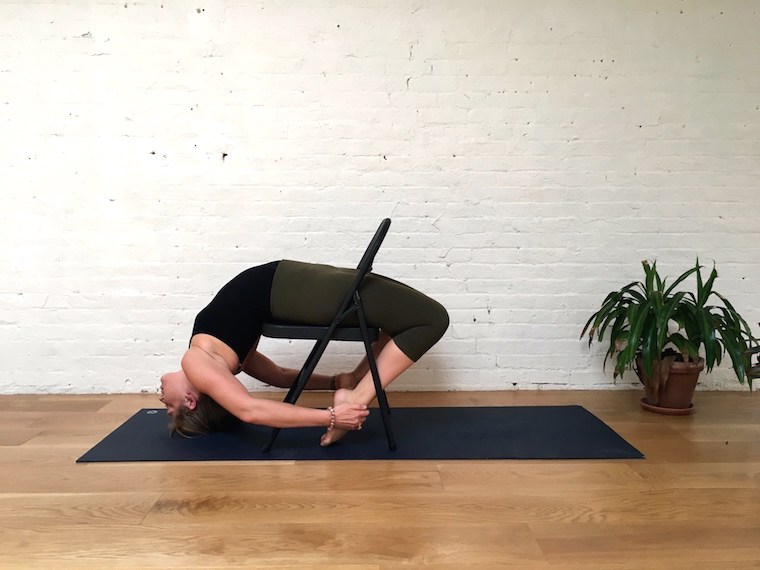
Supported bow pose
Bend knees and place feet on the floor. Slowly come up to sit, facing the back of the chair and take a few deep breaths here.
Wrap feet under chair so the tops of the feet are pressing down into floor (as they would be in upward facing dog pose) and then lower torso, placing a block under the head if needed. Stay in this pose for at least five breaths, inhaling and exhaling deeply.
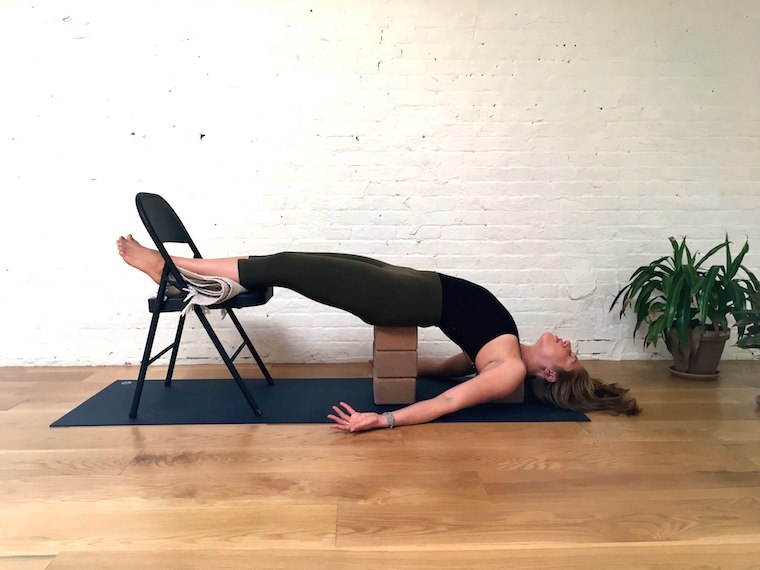
Supported bridge pose
Slowly come out of bow pose and sit upright on the chair for a few deep breaths to prevent dizziness. Come off the chair and lie on your back on the mat with knees bent and feet on the ground, facing the front of the chair.
Press your feet into the floor and, as you take a deep inhalation, lift your hips as high as you can. Come onto your toes to get more height for a moment. Slip one, two, or three blocks, widest side, under your sacrum, the bony triangle at the base of your spine. Your sacrum should rest comfortably on the block, so make any adjustments that you need to. Make sure to place the block closer to your tailbone than to your waist. If you are using three blocks under your sacrum, slide a fourth block under your shoulders to support your neck and shoulders. It may help to work with an instructor here to help position the blocks for you.
Rest your arms alongside your body with your palms face up. Roll your upper arms to face the ceiling. Press your shoulder blades into your back ribs to help lift and open your chest. Extend legs on the chair, feet coming through the back opening. It may help to place a strap around the thighs—and a sandbag over the hips feels very grounding. Stay here for at least a minute, breathing deeply.
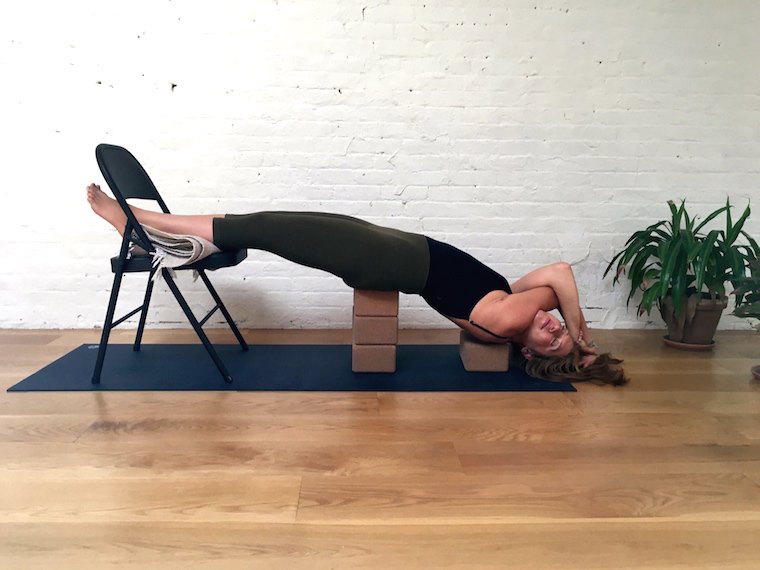
Supported bridge pose with eagle arm variation
Wrap your left arm under your right and lift your elbows up and out, tucking your chin into your elbow crease or upper arm, as you breathe deeply into the back of your throat to nourish your thyroid. Take five deep breaths here, then repeat with the other arm on top.
Keep sending your seat back while lifting your elbows out and up, as you move your shoulders down away from your ears. Swallow to flush your thyroid—this is stimulating and nourishing to your thyroid glands. Try to keep your face sweetly relaxed as you take three deep breaths. Find comfort in the boundaries, and breathe space into the back of your throat. Then release your arms and pause, relaxing arms alongside your body or clasping opposite elbows above your head.
When you’re ready to release the pose, press down with your feet to lift your hips and pelvis up. Remove the blocks and lower your back to the floor slowly, letting each vertebrae gently meet the earth. Pause here for a moment to feel the sweetness wash over you.
Note: If your palms are not pressing together with the eagle arm wrap, that's okay. Just take a hold of the higher wrist and try to pull your wrist up as you lift your elbows. As you do this, squeeze your elbows and forearms together. This arm variation could feel uncomfortable and tight at first—which may mean that you are working to clear blockages and stagnation that has been manifesting in your thyroid gland for quite some time. Try to resist the urge to get frustrated and give up on this very therapeutic pose.
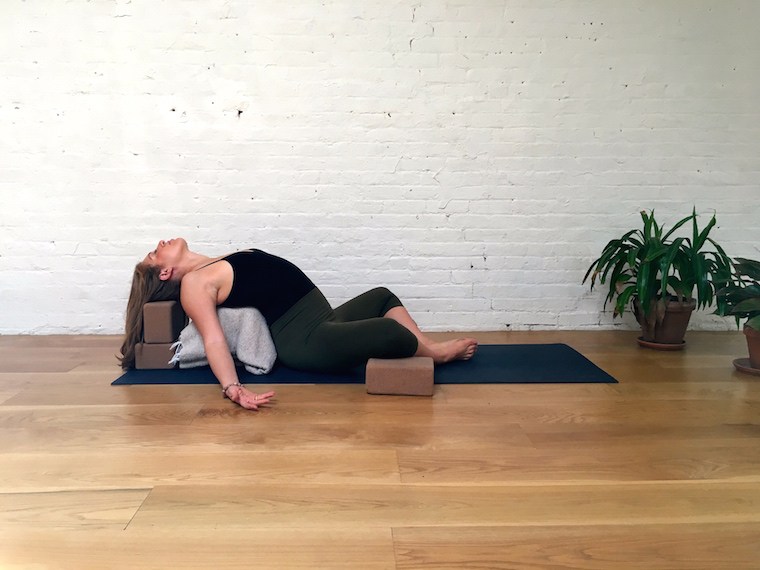
Supported goddess pose
Place two blocks on their highest height next to each other near the top of your yoga mat and cushion them with a blanket folded on top. About six inches from these blocks, place a block on the lowest setting horizontally and stack a block vertically on the highest setting on top. Recline over the blocks with your bra-line at the first blocks, the back of head resting on the second blocks.
Open legs to the side and place feet together in a diamond shape. Cushion under knees with pillows, blankets, or blocks for added support. Stay here for at least a minute, breathing deeply. An eye mask will provide added serenity.
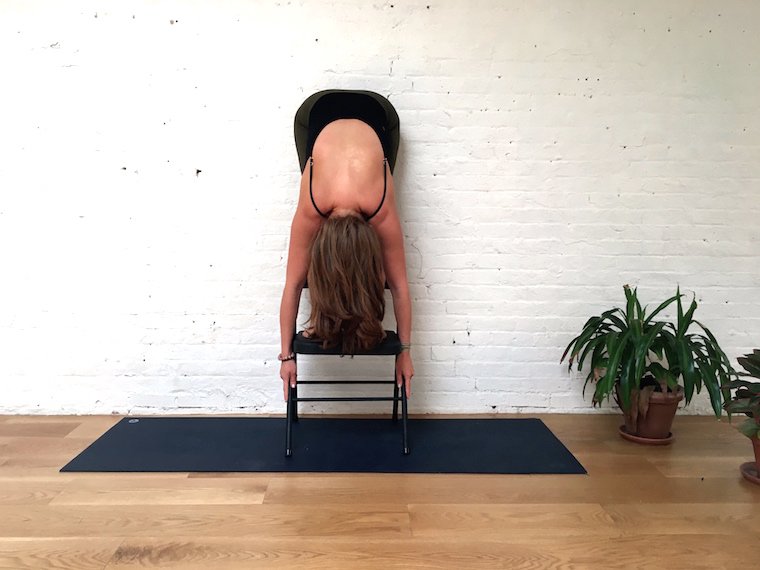
Standing forward fold
Position chair at the wall and stand on chair facing outward, aiming to press the hamstrings and glutes into the wall. Bend knees and tuck them into armpits to create a fit, which is very soothing for the kidneys and adrenals. Allow your head to drop down as your sit bones lift up.
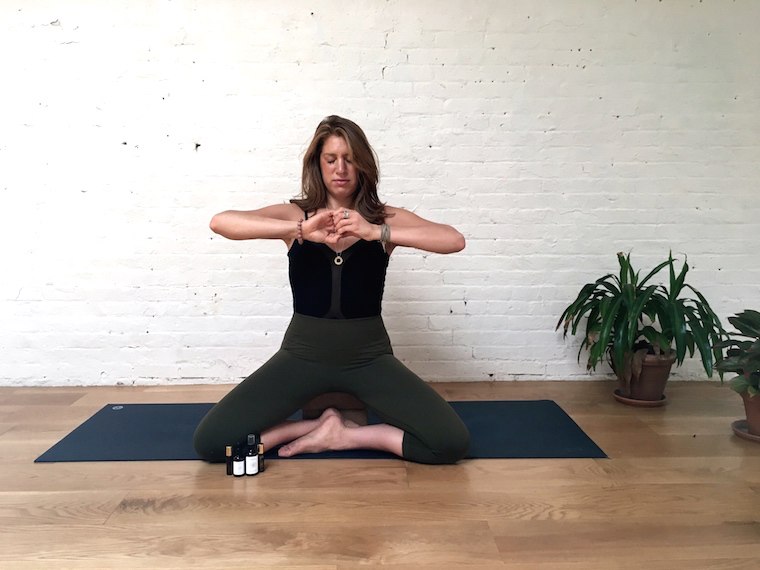
Bearclaw breathwork with twist
At the level of your throat, place the right palm facing the left palm and clasp fingers together, hooking your thumbs and creating tension in the palms, almost as if pulling them apart. Every inhale, twist torso to the left. Each twist to the left sends circulation and blood flow to the heart, which is located on the left side of the body. Every exhale, twist torso to the right.
After three minutes, sit silently with your eyes closed and breathe deeply, noticing the effect of this breath work on your physical and energetic state.
More intel on avoiding weight gain: Why your workouts may actually be sabotaging your metabolism—plus, new research into the important role your microbiome plays.
Loading More Posts...
